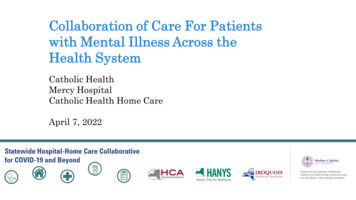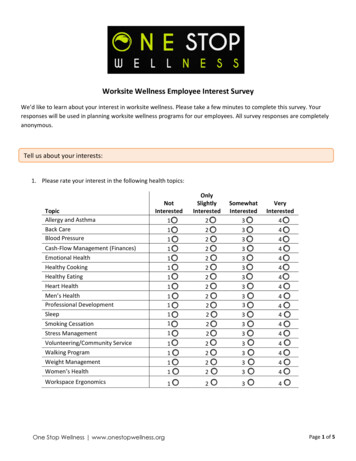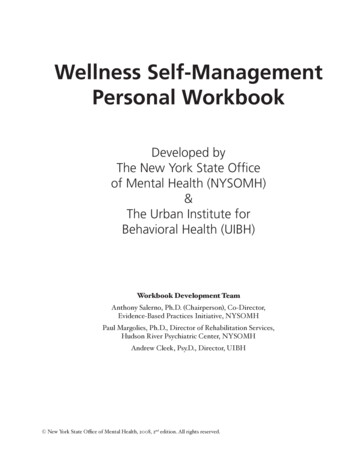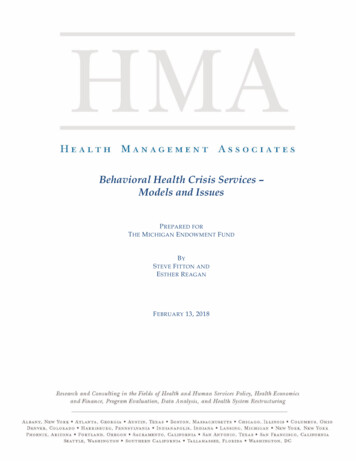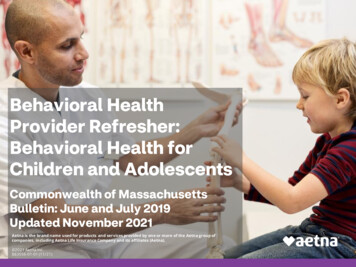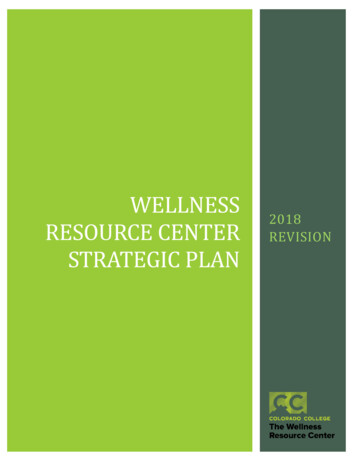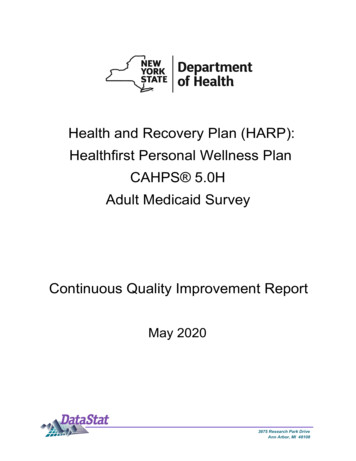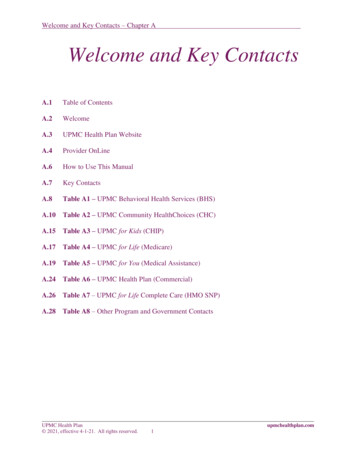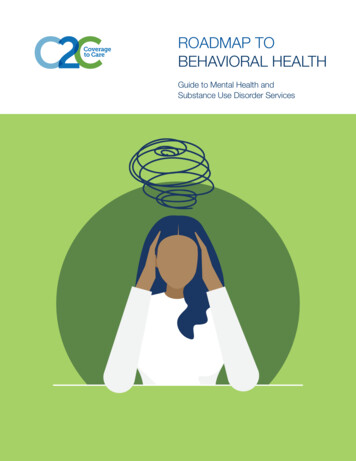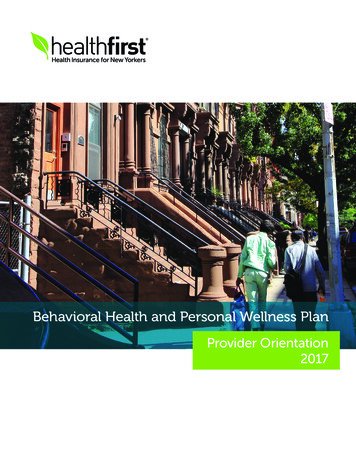
Transcription
Behavioral Health and Personal Wellness PlanProvider Orientation2017
Table of ContentsIntroduction.3Overview. 4The Healthfirst Personal Wellness Plan. 6Eligibility.7Screening Tools. 8HCBS. 9Model of Care.11Cultural Competence.12Barriers to Care.14Authorization Requirements.15Claims Filing Guidelines.17After-Hours Support. 20Provider Credentialing.21Compliance. 222Behavioral Health and Personal Wellness Plan
IntroductionHealthfirst is a provider-sponsored health insurance company that serves more than1.2 million members in downstate New York. Healthfirst offers top-quality Medicaid,Medicare Advantage, Child Health Plus, and Managed Long Term Care plans. HealthfirstLeaf Qualified Health Plans and the Healthfirst Essential Plan are offered on NY State ofHealth, The Official Health Plan Marketplace. Beginning in 2017, Healthfirst is offeringHealthfirst Pro and Pro Plus, Exclusive Provider Organization (EPO) plans for small-businessowners and their employees, and Healthfirst Total, an EPO for individuals.For more information on Healthfirst, visit www.healthfirst.org.Established in 1993, Healthfirst was an early pioneer in aligning incentives and goals withthe provider delivery system through comprehensive value-based payment approaches.Today, with its provider partners, it is at the forefront of healthcare reform as it continuesto build upon its collaborative model to offer the best in quality and member-centric care.It is a 4-Star Medicare Advantage plan for the third year in a row.Our MissionAt Healthfirst, our mission is to ensure that our members have superior healthcareand satisfaction. We fulfill this promise through our partnerships and, together, willtransform the system so that it is accountable for the cost and quality of healthcare forour populations.Our VisionOur vision is to treat our members with the same care and attention we would wantfor our own families.Our ValuesnMembers FirstnQuality Execution and Continuous ImprovementnCooperationnIntegrity and Transparency3
OverviewBehavioral Health Transition to Managed CareMental illness and substance use disorders are known to have significant impacton the function of people and their ability to manage chronic physical illnesses.In 2011, the Medicaid Redesign Team (MRT) was created to improve the quality ofthe Medicaid program, with a focus on transitioning behavioral health services intomanaged care.Behavioral Health benefits transitioned to Managed Care for New York Cityon October 1, 2015. In addition, Behavioral Health benefits transitioned to Managed Carefor the Rest of State (ROS), including Long Island, on July 1, 2016.This means that individuals currently enrolled with Healthfirst who receive theirbehavioral health services through fee-for-service Medicaid will now have theseas a part of their Healthfirst Medicaid plan coverage. This change will offer morebenefits and increased access to services to choose from.Health and Recovery Plans (HARPs)nT he HARP program was developed to better assist adults diagnosed with seriousmental illnesses (SMI) and substance use disorders (SUD) in their recoverynE ligible adults enrolled in a HARP have the full coverage provided underthe standard Medicaid plan, PLUS the ability to access enhanced benefitsnT hese benefits include Behavioral Health Home and Community BasedServices (BH-HCBS)Behavioral Health Home and CommunityBased Services (BH-HCBS)nH ARPs will utilize BH-HCBS to provide opportunities for Medicaid beneficiarieswith SMI and/or SUD to receive person-centered, recovery-oriented servicesin their own communityn BH-HCBS help to create an environment where managed care plans, providers,members, and their families partner to help prevent and manage chronic healthconditions and support the recovery efforts of people with serious mental illness andsubstance use disorders4Behavioral Health and Personal Wellness Plan
Behavioral Health Benefits PackageThe enhanced benefit package includes:nInpatient – SUD and MHnClinic – SUD and MHnPersonalized Recovery-Oriented Services (PROS)nIntensive Psychiatric Rehabilitation Treatment (IPRT) ProgramsnAssertive Community Treatment (ACT)nContinuing Day Treatment (CDT)nPartial HospitalizationnComprehensive Psychiatric Emergency Programs (CPEP)nCrisis Services (including Mobile Crisis Intervention)nOpioid Treatment ProgramsnOutpatient Chemical Dependence RehabilitationnRehabilitation Services for Residential SUD Treatment SupportnRehabilitation Supports for Community ResidencesnBuprenorphine PrescribersThe benefit package also includes:nBehavioral Health Home and Community Based Services (BH-HCBS)Behavioral Health Transition TimelinenO ctober 1, 2015Behavioral Health Services are carved in to Managed Care Plans and HARPsnJ anuary 1, 2016Eligible HARP members in New York City can begin accessing Behavioral HealthHome and Community Based Services (BH-HCBS)nJ uly 1, 2016Mainstream plan behavioral health management and phased HARP enrollment beginfor the rest of NYS (including Long Island)nO ctober 1, 2016Eligible HARP members in ROS (Long Island) can begin accessing Behavioral HealthHome and Community Based Services (BH-HCBS)nJ uly 1, 2017Behavioral Health Services are carved in to Managed Care Plans for Children in NewYork City and Long Island5
The Healthfirst Personal Wellness PlanThe Healthfirst Personal Wellness Plan (PWP) is the Healthfirst HARP. It is a qualified,specialized, and integrated managed care product for individuals with significant behavioralhealth needs (serious mental health illness and/or substance use disorders).Healthfirst PWP member ID card:Personal Wellness PlanRxBin 004336 RxPCN ADV RxGrp RX1113Jane DoeMember ID: XX00000XNon-Preferred Brand DrugsGeneric/Preferred DrugsNon-Prescription(over the counter) DrugsCopay 0 0 0Visit MyHFNY.orgThis is a sample image of a HARP member ID card.6Behavioral Health and Personal Wellness Plan
EligibilityMedicaid beneficiaries who are eligible for Medicaid Managed Care may also be eligiblefor enrollment in the Healthfirst Personal Wellness Plan. Individuals must meet the State’starget criteria (outlined below) and certain risk factor criteria.nMedicaid-enrolled individuals over the age of 21nDiagnosis(es) of SMI and/or SUDnEligible to be enrolled in Medicaid Managed Care health plansnNot enrolled in Medicaid/Medicare (dual-eligible)nNot enrolled in a Managed Long Term Care (MLTC) Plann Not participating or enrolled in a program with the Office for People withDevelopmental Disabilities (OPWDD)Eligibility for BH-HCBSThe Community Mental Health Assessment is a person-centered, standardizedassessment tool that informs and guides comprehensive care and service planningin community-based settings.nFocuses on quality of life by assessing individual needs, strengths, and preferencesn Provides the foundation for an outcome-based assessment of the person’sresponse to care or servicesn Used to assess chronic needs for care in individuals as well as those withpost-acute care needs (e.g., after hospitalization)Components of the Community Mental Health Assessment will be utilized to identifyBH-HCBS eligibility:nTier 1 – employment, education, and peer supportnTier 2 – full spectrum of BH-HCBS7
Screening ToolsnL OCADTR 3.0Substance Use Disorder level-of-care assessment toolnM cKesson’s InterQualMental Health level-of-care assessment toolnC ommunity Mental Health AssessmentLevel-of-care assessment and BH-HCBS eligibility tooln Patient Health Questionnaire (PHQ-2/PHQ-9)Depression assessment tooln Generalized Anxiety Disorder 7-item (GAD-7) ScaleAnxiety screening tooln Columbia Suicide Severity Rating ScaleSuicide risk screening tool8Behavioral Health and Personal Wellness Plan
HCBSHealth HomeA Health Home is a service delivery model that offers care coordination to members inorder to connect all service providers and ensure each member’s needs are addressed ina comprehensive manner.nE ach member is connected with a unique Care Manager who oversees coordinationof care and facilitates access to all services needed to ensure members receiveeverything necessary to stay healthy and out of the hospital or ERnO ne unified care plan is shared among providers so that services are not duplicatedor neglectednH ealth Home services are provided through a network of providers, health plans,and community-based organizations, collectively making a virtual “Health Home”A Health Home is NOT:nHome HealthnHome CarenPersonal Care Agency (PCA)nPatient-Centered Medical Home (PCMH)BH-HCBSAll Behavioral Health Home and Community Based Services are aimed at achievingrecovery. Recovery is the process of change through which individuals improve their healthand wellness, live a self-directed life, and strive to reach their full potential.There are 14 different BH-HCBS:nPsychosocial RehabilitationnCommunity Support and Treatment (CPST)nHabilitation ServicesnFamily Support and TrainingnShort-term Crisis RespitenIntensive Crisis Respite9
BH-HCBS, continuednEducation Support ServicesnPeer Support ServicesnNon-medical TransportationnPre-vocational ServicesnTransitional EmploymentnIntensive Supported EmploymentnOngoing Supported EmploymentnSelf-directed CareAll PWP members are eligible to be enrolled in a Health Home, and everyeffort will be made to do so.The Health Home will manage assessment of the PWP member for BH-HCBS.The Health Home develops the initial and ongoing plans of care and obtainsHealthfirst's approval.WorkflowA Healthfirst PersonalWellness Planmember is assignedto a Health Home forcare coordinationThe Health Homecompletes the brief,comprehensiveassessmentto determine themember’s eligibilityfor Tier 1 or Tier 2BH-HCBSA plan of care isdeveloped as aroadmap and isshared withHealthfirst forreview andapprovalThe memberis connectedto therecommendedBH-HCBSOngoingmonitoring of planof care by CM,with collaborationbetween themember andprovidersThe CM will continue to work on completing the Full Community Mental Health Assessment within 90 daysand update the plan of care if needed. This is done without holding up BH-HCBS or other referrals.The MCO will monitor for completion.10Behavioral Health and Personal Wellness Plan
Model of CareThe Core Team:nHome Health Care Coordinator (CC)nHealthfirst RN Case Manager (telephonic)nHealthfirst Care Coordinator (telephonic)nHealthfirst Behavioral Health Care ManagernPrimary Care Provider (PCP)nPrimary Behavioral Health CliniciannTherapist (as ealth HomeCoordinatorSocialServicesOther Potential Team Members:nSpecialty Care PhysiciansnHome Care NursesnResidence ManagersnSocial WorkersnPeersnOther CaregiversnFamily and Community SupportsBHProviderSubstance UseTreatment11
Cultural CompetenceCultural competence represents the ability to interact effectively with peopleof different cultures, conditions, and socioeconomic backgrounds.Healthfirst services a diverse member population, and it is important that ournetwork providers understand and are prepared for the cultural context of thecommunities they service.Healthfirst providers must exercise sensitivity on religious, ethnic, and socioeconomiccultural differences of the members they serve.People with disabilities face barriers to care at provider sites. So it is importantto maintain a culturally competent practice and to address barriers such as:nPhysical BarriersnCommunication BarriersnPerception Barriers and Lack of TrainingLinguistic CompetencyProviders must ensure that services and information about treatment are providedin a manner consistent with the member’s ability to understand what is beingcommunicated. Members of different racial, ethnic, and religious backgrounds, aswell as individuals with disabilities, should receive information in a comprehensible mannerthat is responsive to their specific needs.If foreign-language barriers exist, a family member, friend, or healthcare professionalwho speaks the same language as the member may be used (at the member’sdiscretion) as a translator.If a member has hearing, cognitive, or visual impairments, appropriate methodsfor communication—sign language materials, braille, large print, audio tapes, or simplelanguage for medical forms and instructions—should be made available.12Behavioral Health and Personal Wellness Plan
Physical AccessibilityADA Guidance for Physical AccessibilityIn keeping with the guidelines of the Americans with Disabilities Act (ADA), accessibility ofdoctors’ offices, clinics, and other healthcare providers is essential in providing medicalcare to people with disabilities. All medical, behavioral, and community- and facility-basedLong Term Services & Support (LTSS) network providers should be knowledgeable aboutand adhere to the physical accessibility standards as defined by the U.S. Department ofJustice ADA guidance for providers, in the following areas:nP roviding reasonable accommodations—sign language materials, braille, large print,audio tapes, or simple language for medical forms and instructions—to those withhearing, vision, cognitive, and psychiatric disabilitiesnU tilizing furniture that meets the needs of all participants, including those withphysical and non-physical disabilities. Ensure there are no obstructions inpathways that would inhibit free movement and that pathways are navigable,safe, and accessiblenU tilizing clear signage and directional text or symbols (e.g., colored arrows)throughout facilitiesBenefits of Cultural CompetencynE xpand your patient base by providing more culturally and linguistically appropriatecare to a wider diversity of patientsnD eliver a higher quality of care to help your patients meet their healthcare goals,while honoring and respecting their cultural beliefs and practicesnD ecrease clinical errors that may arise due to cultural and linguistic differences incommunication and differences in health literacy13
Barriers to CarePeople with disabilities face barriers to care at provider sites. So it is important tomaintain a culturally competent practice and to address barriers such as:nPhysical BarriersnCommunication BarriersnPerception Barriers and Lack of TrainingBarriers to care caused by Behavioral Health issues:nL ack of coordination between behavioral health and other medicaland non-medical servicesnC ognitive deficits, psychiatric and behavioral disturbances impactingadherence to treatmentnComplex health needsnIncorrectly diagnosed conditionsnInsufficient treatmentnUntreated conditionsnLack of reasonable accommodationsExamples for handling barriers to care:nIndividuals with serious mental illness and substance use disorders: Take a nonjudgmental approach and refer them to appropriatebehavioral health providersnIndividuals with intellectual disabilities: rovide written materials at a basic level and give them assistance withPunderstanding the informationnIndividuals with dementia or Alzheimer’sAssess their understanding and accommodate them appropriately14Behavioral Health and Personal Wellness Plan
Authorization RequirementsAuthorization for the following services is not required; however, we request that younotify Healthfirst of admission within 48 hours:nC omprehensive Psychiatric Emergency Program (CPEP)nC ontinuing Day Treatment (CDT)nI ntensive/Supportive Case Management (ICM/SCM)n Rehabilitation for residents of community residencesn Authorization for traditional in-network outpatient behavioral health servicesprovided by Healthfirst providers is not requiredn Traditional outpatient Behavioral Health Services, as defined by Healthfirst forthis purpose, include individual, group, and family therapy, and medicationmanagement, provided alone or in any combination, to treat a behavioral healthcondition in a manner consistent with established clinical guidelines and provided ata frequency not exceeding five (5) hours a week.The following services require prior authorization. These will also be subject toretrospective and concurrent reviews in accordance with the policies and procedures:nM ental Health (MH) Services:InpatientPartial Hospitalization Programs (PHP)nS ubstance Use Disorder (SUD) Treatment:Inpatient DetoxificationInpatient RehabilitationResidential RehabilitationSubstance Use Partial Hospitalization Programn BH-HCBS – HARP Onlyn Ambulatory Detox15
Authorization Requirements, continuedAuthorization is required for the following outpatient services:n Electroconvulsive Therapy (ECT)n Neuropsychological TestingnA ssertive Community Treatment (ACT)nP ersonalized Recovery-Oriented Services (PROS)nI ntensive Outpatient Program (IOP) for Mental HealthnP sychological TestingBehavioral Health providers must obtain prior authorization by contactingHealthfirst at 1-888-394-4327 or by faxing a request to 1-646-313-4603.Providers requesting authorization for BH-HCBS, ACT, and PROS should faxrequests to 1-646-313-4612.16Behavioral Health and Personal Wellness Plan
Claims Filing GuidelinesProviders must submit claims for reimbursement of services delivered. These claimsalso serve as encounter data for services rendered under a capitation arrangement.Providers should never bill Healthfirst members for covered services. Mental Health,Substance Use Disorder (SUD) facilities, and outpatient clinic service claims must besubmitted to Healthfirst either electronically, using the 837(I), or through Institutionalpaper claims, using the UB-04 claim form.Timely Filing:Clean claims must be submitted within 180 days of the date of service.Claims can be submitted on paper by sending them to:Healthfirst Claims DepartmentP.O. Box 958438Lake Mary, FL 32795-8438OR submit claims electronically and enjoy the following benefits:nF aster submission of claimsnF aster tracking of claimsn Improved cash forecasting and cash flowSubmitting Claims ElectronicallyFor all electronic claims, Healthfirst utilizes the Change Healthcare clearinghouse andAbility, a FREE online service for providers who do not have claims-submission software.To sign up for electronic billing with Change Healthcare, providers must contact theirsoftware vendor and request that their Healthfirst claims be submitted through ChangeHealthcare. Providers can also direct their current clearinghouse to forward claims toChange Healthcare.Please call Healthfirst at 1-888-801-1660 to set up electronic billing.To sign up for electronic billing with Ability or for more information,visit www.healthfirstmdol.com or call 1-888-499-5465.Providers who sign up for electronic billing may also sign up for electronic fund transfer/electronic remittance advice (EFT/ERA).17
Submitting Claims Electronically, continuedClaims submitted electronically must include:nT he Healthfirst Payor ID Number 80141nT he Member ID NumbernT he Provider NamenT ax ID NumbernF acility NPI NumbernP rovider Billing AddressnT he Authorization NumbernV alid Procedure Code(s)nR ate Code/Value CodenV alid Diagnosis Codes (appropriate ICD-10 version)nP rocedure Code Modifiers (as needed)nU nits of ServicenA nd for Physician and Outpatient Administered Drugs, theCorresponding NDC Code, NDC Metric Unit, and Unit of MeasureReviews and ReconsiderationsnR equests must be made in writing, with supporting documentationn Request within 90 days from the paid date on the Explanation of Payment (EOP)nR equests are accepted through the Healthfirst secure Provider Portal ormay be mailed to:Healthfirst Correspondence UnitP.O. Box 958438Lake Mary, FL 32795-8438nA ppeal the outcome of a review and reconsideration in writing, with supportingdocumentation, within 60 days from the date listed on the reconsideration letterand send to:Provider Claims AppealsP.O. Box 958431Lake Mary, FL 32795-843118Behavioral Health and Personal Wellness Plan
Corrected ClaimsClaims can be submitted through an Electronic Data Interchange (EDI) or by paperwithin 180 days.nE DI is the computer-to-computer transfer of business-to-business document transactionsand information between trading partners. Many healthcare partners, payors, vendors, andfiscal intermediaries choose EDI as a fast, inexpensive, and safe method for automatingbusiness processes. For more information, visit www.healthfirst.org/providers/claims-billingnP aper claims can be submitted on the CMS-1500 (professional) and UB-04 (institutional)forms (whichever is applicable). "Corrected Claim" should be clearly marked on the claim,along with the original claim numberCorrected claims must include the original claim number. Failure to provide the original claimnumber on the corrected claim will result in the claim being rejected or denied as a duplicate.To submit corrected claims via mail:Healthfirst Claims Correspondence UnitP.O. Box 958438Lake Mary, FL 32795-8438Electronic Funds Transfer (EFT)& Electronic Remittance Advice (ERA)n The electronic exchange or transfer of money from one account to another,which reduces mailing costs overall. No stuffing of envelopes and no printingn The electronic payments are sent much faster every weekn ERAs are processed electronicallyn EFT/ERA is safe, secure, and efficientn EFT money is available right away with direct deposit to a checking accountn No lost checksBalance BillingHealthfirst Personal Wellness Plan members are not subject to copays, deductibles, orcoinsurance, and Healthfirst providers may not balance-bill members for the difference betweentheir actual charges and the reimbursed amounts for covered services. Any such billing violatesboth the provider’s agreement with Healthfirst and applicable New York State law. It is theprovider’s responsibility to educate their staff, any contracted billing services, and affiliatedproviders concerning this contract requirement.19
After-Hours SupportAppointment availability standards for Behavioral Health providers by service type canbe found online on the NYSDOH website.Healthfirst will periodically audit providers for compliance with these standards.Mental Health Association of NYC (MHA):Healthfirst’s after-hours provider, staffed with mental health professionals, that assistswith any Behavioral Health call of an emergent, urgent, or critical nature.MHA will also assist providers calling for members seeking admission to a facility orprogram for treatment of any psychiatric or substance abuse disorder or treatment at anylevel of care.Healthfirst PWP Member Services: 1-855-659-5971Healthfirst Member Services: 1-866-463-674320Behavioral Health and Personal Wellness Plan
Provider CredentialingProvider Application ProcessParticipating facilities and individual providers should contact their Network ManagementRepresentative to notify Healthfirst about new providers joining existing practices or toinquire about how to become a participating provider. Providers who wish to join thenetwork must complete a preliminary application for review. Should the provider bedeemed a desirable candidate, he or she will then be required to complete an applicationpackage and to submit the appropriate credentialing documents.Credentialing and Re-credentialing RequirementsProviders are initially credentialed through approved delegation agreements withparticipating hospitals. They are re-credentialed biannually through the same process,or every three (3) years through a review conducted by Healthfirst.Voluntary TerminationsAll providers who wish to terminate their contractual relationship with Healthfirstare bound by the applicable provisions of their Healthfirst agreement.All providers voluntarily terminating their affiliation with Healthfirst must give 90 daysprior written notice of the termination, or written notice as set forth in the agreementwith Healthfirst.Verbal notification is not sufficient to initiate the termination process.21
ComplianceFirst Tier, Downstream and Related Entities (FDRs)and Affiliate DefinitionsFirst Tier Entity: Any provider or facility directly contracted with Healthfirst who providesservices to Medicare enrollees in the Medicare Advantage or Part D program.Downstream Entity: Any provider or entity that has a written agreement with a First TierEntity and that provides services to Medicare enrollees in the Medicare Advantage orPart D program.Related Entity: Any entity that is related to an MAO or Part D sponsor by commonownership or control and that:n Performs some of the MAO or Part D plan sponsor’s management functions undercontract or delegationn Furnishes services to Medicare enrollees under an oral or written agreement; orn Leases real property or sells materials to the MAO or Part D plan sponsor at a costof more than 2,500 during a contract periodAffiliate: An affiliate is a person, provider, or entity who provides care, services, or suppliesunder the Medicaid program, or a person who submits claims for care, services, or suppliesfor or on behalf of another person or provider for which the Medicaid program isor should be reasonably expected by a provider to be a substantial portion of theirbusiness operations.Compliance RequirementsAs of January 1, 2013, Healthfirst requires each First Tier Entity and Affiliate to complete anannual Compliance Attestation to confirm compliance with the following requirements:n Reporting of fraudulent, wasteful, and abusive activitiesn The policy listed in section 3.3 of the Healthfirst Provider Manual,and all applicable federal and state regulations on:Standards of conduct and complianceFraud, waste, and abuse trainingOIG and GSA exclusion screeningThis attestation can be completed online at www.healthfirstFDR.org. In addition, FirstTier Entities are responsible for ensuring that their downstream and related entities are incompliance with this policy and with applicable federal and state statutes and regulations.22Behavioral Health and Personal Wellness Plan
Reporting Potential Fraud, Waste, and AbuseThere are three ways to report this with Healthfirst:n Confidential Healthfirst Hotline: 1-877-879-9137n Confidential Healthfirst Website: www.hfcompliance.ethicspoint.comn Confidential Healthfirst Email: compliance@healthfirst.orgAll Healthfirst vendors, providers, and First Tier, Downstream and Related Entities (FDRs)are expected to bring any alleged inappropriate activity which involves Healthfirst toour attention.Healthfirst maintains a strict policy of zero tolerance toward fraud, waste, and abuseand other inappropriate activities.23
Healthfirst is the brand name used for products and services provided by one or more of the Healthfirst group of affiliated companies. 2016 HF Management Services, LLC.
Health and Recovery Plans (HARPs) n The HARP program was developed to better assist adults diagnosed with serious mental illnesses (SMI) and substance use disorders (SUD) in their recovery . Mainstream plan behavioral health management and phased HARP enrollment begin for the rest of NYS (including Long Island) n October 1, 2016
